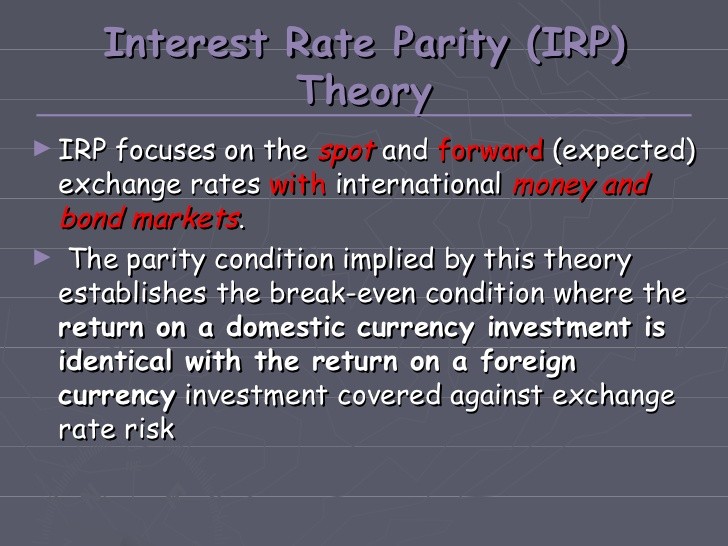PPT International Parity Conditions PowerPoint presentation
Post on: 27 Июль, 2015 No Comment

International Parity Conditions
Parity Conditions provide an intuitive explanation of the movement of prices and. NOTE Parity Conditions are expected to hold in the long-run, but not always in. PowerPoint PPT presentation
Title: International Parity Conditions
International Parity Conditions
- Reading Chapter 4
Class Outline
- Introduction to Parity Conditions
- Absolute Relative Purchasing Power Parity
- Real Exchange Rate
- Fisher Effect (FE)
- International Fisher Effect (IFE)
- Unbiased Forward Rate (UFR)
- Interest Rate Parity (IRP)
- Covered Interest Arbitrage
- Currency Forecasting gt PROJECT
Introduction
- Managers of multinational firms, international
investors, importers and exporters, and
government officials must deal with these
fundamental issues
exchange rate?
understand the economic fundamentals of
international finance, known as parity conditions.
Parity Conditions
- Parity Conditions provide an intuitive
explanation of the movement of prices and
interest rates in different markets in relation
to exchange rates.
assumption of Perfect Capital Markets (PCM).
the long-run, but not always in the short term.
is the Law of One Price (LOP).
should be the same in all markets (assuming no
transactions costs).
good in the cheap market and reselling it in the
The Law of One Price
from the relative local product prices
LOP Example
- Pwheat, Aust 4/bushel and Pwheat, UK
The Big Mac Index
- The most famous test is The Economist magazines
Big Mac Hamburger standard.
(No Transcript)
Research on the Big Mac Index
- Pakko and Pollard (1996) conclude that Big Mac
PPP holds in the long-run, but currencies can
deviate from it for lengthy periods. They note
several reasons why the Big Mac index may be
flawed
utilities, labor) are also inputs that affect
Relative Purchasing Power Parity
should exactly offset any inflation differential
between two countries
Percentage change in domestic prices
Relative PPP
- We can also write
Relative PPP
- Relative PPP implies that the change in the
exchange rate will offset the difference between
the relative inflation of two countries.
in domestic and foreign price levels respectively
and ?s to the percentage change in the exchange
rate.
PPP predicts the domestic currency should
depreciate (appreciate).
Relative PPP Example
- Given inflation rates of 5 and 10 in Australia
and the UK respectively, what is the prediction
of PPP with regards to A/GBP exchange rate?

countries with high rates of inflation will see
their currencies depreciate against those with
low rates of inflation.
How well does PPP work?
- We have seen that the strictest version of PPP
that all goods and financial assets obey the law
of one price is demonstrably false.
relative inflation rates and changes in exchange
rates.
decline (gain) in purchasing power see the
sharpest erosion (appreciation) in their foreign
exchange values.
Relative Purchasing Power Parity
- Applications of Relative PPP
- Forecasting future spot exchange rates.
- Calculating appreciation in real exchange
Real Exchange Rate
- Appreciation/depreciation in the real exchange
rate measures deviations from PPP.
correctly. The competitiveness of this country
The Fisher Effect
of the future rate of inflation, not what
inflation has been in the past.
The International Fisher Effect
- The International Fisher Effect (also called
Fisher-open) states that the spot exchange rate
should change to adjust for differences in
Tests of the International Fisher Effect
- Empirical tests lend some support to the
relationship postulated by the international
Fisher effect (currencies with high interest
rates tend to depreciate and currencies with low
interest rates tend to appreciate), although
Unbiased Forward Rate (UFR)
- Some forecasters believe that for the major
floating currencies, foreign exchange markets are
efficient and forward exchange rates are
unbiased predictors of future exchange rates.
that the forward exchange rate, quoted at time t
for delivery at time t1, is equal to the
expected value of the spot exchange rate at time
Unbiased Forward Rate (UFR)
- An unbiased predictor, however, does not mean the
Empirical Tests of UFR
- A consensus is developing that rejects the
efficient market hypothesis.
unbiased predictor of the future spot rate and
that it does pay to use resources in an attempt
Approximation of IRP
- In general, the currency trading at a forward
premium (discount) is the one from the country
with the lower (higher) interest rate.
Interest Rate Parity Why It Holds
- This must hold by arbitrage. Otherwise riskless
profits could be made. This is known as covered
interest arbitrage (CIA) and occurs whenever IRP
does not hold. CIA can involve the following
steps
currency in the spot market
interest-bearing instrument and then
exchange rate at which to convert the foreign
currency proceeds back to the domestic currency.
Covered Interest Arbitrage Example
- The annual interest rate in the AUS and UK are 5
and 8 respectively. The current spot rate is
1.50/ and the 1 year forward rate is 1.48/.
Can arbitrage profits be made?
years time)














